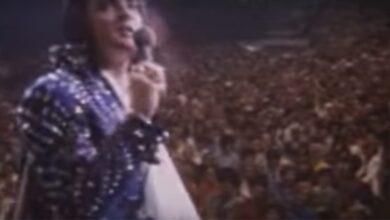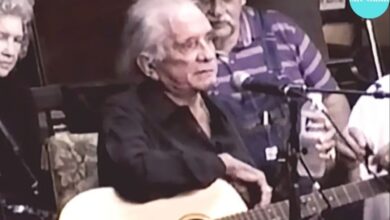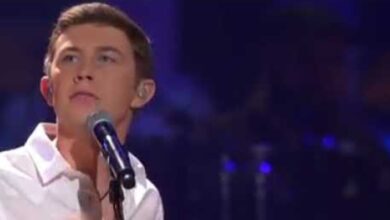Eddy Arnold And LeAnn Rimes Showcased An Impressive Yodeling Duel In Their “Cattle Call” Performance
Eddy Arnold, born on May 15, 1918, in Henderson, Tennessee, is often remembered as a groundbreaking figure in country music. His career spanned several decades, and he became one of the genre’s most beloved artists. Arnold’s smooth baritone voice, combined with his distinctive yodeling technique, allowed him to bridge the gap between traditional country and popular music styles. During the 1940s and 1950s, he became known as the “Tennessee Plowboy,” a nickname that reflected both his roots and his identity as a country artist.
Arnold grew up in a musical family and began singing in church at a young age. His early influences included gospel music and the sounds of the Grand Ole Opry, where he was inspired by the likes of Roy Acuff and others. His first radio broadcast came in 1937, and over the years, he honed his skills in yodeling, which would later define much of his musical style. By the time he recorded “Cattle Call,” Arnold was well on his way to becoming a significant figure in the country music scene.
“Cattle Call” was a pivotal moment in Arnold’s career. His unique approach to the song, characterized by its inviting melodies and vivid storytelling, showcased his ability to connect with audiences on an emotional level. The lyrics of “Cattle Call” detail a cowboy’s longing for his cattle and the rhythm of ranch life, reflecting themes of solitude, companionship, and the beauty of the American landscape. This narrative depth, combined with Arnold’s yodeling, enchanted listeners and helped the song become a defining piece of mid-century country music.
The song’s success extended beyond the boundaries of country music. Its inviting melody and relatable themes allowed “Cattle Call” to break into mainstream popularity, making it accessible to a wider audience. Eddy Arnold’s crossover success was augmented by the growing popularity of country music during this time, as it began to reach listeners across various music genres. This paved the way for future artists to experiment with blending country with pop, rock, and other musical influences.
In the years following its release, “Cattle Call” became a staple in the repertoires of various artists, reflecting its timeless appeal. Prominent figures in music, including Johnny Cash and even contemporary artists, have drawn inspiration from Arnold’s original rendition. Elvis Presley’s cover in 1969 is perhaps one of the most notable, as it introduced the song to a whole new audience and highlighted Presley’s own versatility as an artist. His version echoed the sentiments of the original while infusing it with his trademark rockabilly flair, ensuring the song’s legacy lived on through different generations.
The cultural significance of “Cattle Call” goes beyond its musicality; it taps into a rich tradition of storytelling synonymous with country music. The song embodies the romanticized life of the cowboy, a figure who represents freedom, adventure, and resilience in the face of challenges. As listeners engage with the lyrics, they visualize the vast, open landscapes and the strong connection between the cowboy and his cattle, encapsulating the spirit of the American West.
The longevity of “Cattle Call” can also be attributed to its incorporation of the yodeling technique, which Arnold mastered and popularized. Yodeling, often associated with the Alps and Swiss culture, found a unique home in country music through Arnold’s use. This distinctive element helped set his work apart from contemporaries and contributed to the song’s memorable quality.
Moreover, Arnold’s influence extended beyond his recordings; he was a prolific performer and appeared on major television shows, helping to bring country music into the homes of many Americans. His charisma and stage presence endeared him to fans, while his recordings continued to resonate through the airwaves, shaping the soundscape of the era.
As country music has continued to evolve, artists have revisited and reinterpreted classic songs like “Cattle Call,” ensuring that their essence remains alive in contemporary culture. The song not only represents a moment in time but serves as a bridge that connects past generations with modern audiences. Each cover adds a unique perspective, reflecting the artists’ personal styles while honoring Arnold’s original vision.
In summary, “Cattle Call” remains a cornerstone of country music history, with Eddy Arnold at its epicenter. His successful blending of traditional elements with contemporary sounds and relatable storytelling has left an indelible mark on the genre. As new artists continue to draw inspiration from Arnold’s legacy, the song serves as a reminder of the rich tapestry of country music, where each note and lyric contributes to the ongoing story of American life through song.





